
Cruz Miguel Ortíz Cuadra
This interview is very special to us. Not only was Cruz kind enough to agree to be this month’s ASFS spotlight member, but he had to go to extraordinary lengths to do so, by dealing with limited electricity to run his computer and spotty-at-best internet connection. We are certain his time and energy might have been better served making sure his basic needs were met, but we truly appreciate that he was so generous with us, sharing his unique perspective and observations. -Beth & Greg
From looking at historical cases, we see people using great ingenuity and creativity when they face a food crisis or a dearth of food. What examples of this have you seen in Puerto Rico?
Food crises have been with Puerto Ricans through history. During the Spanish conquest, when the majority of Taino Indians were forced to work in las vetas auriferas [gold mines], reducing cassava cultivation for a long period, those who could escape to the mountains probably resorted to eating marunguey (Zamia pumila, Zamia debilisi), a poisonous tuber that the Taino had learned to use by making a bread from its roots. Older rural people followed a tradition where, once the bread was ready, it was put out in the open until it began to ferment and bugs started to eat it. Informants say the bread is then ready to eat, as the poisons have been extracted by the insects.
In the 18th century, chronicler monk Inigo Abad documented the use of marunguey bread in the aftermath of hurricanes. Zamia is still abundant in Puerto Rico and it will likely serve as food if the knowledge of its production and processing is still remembered.
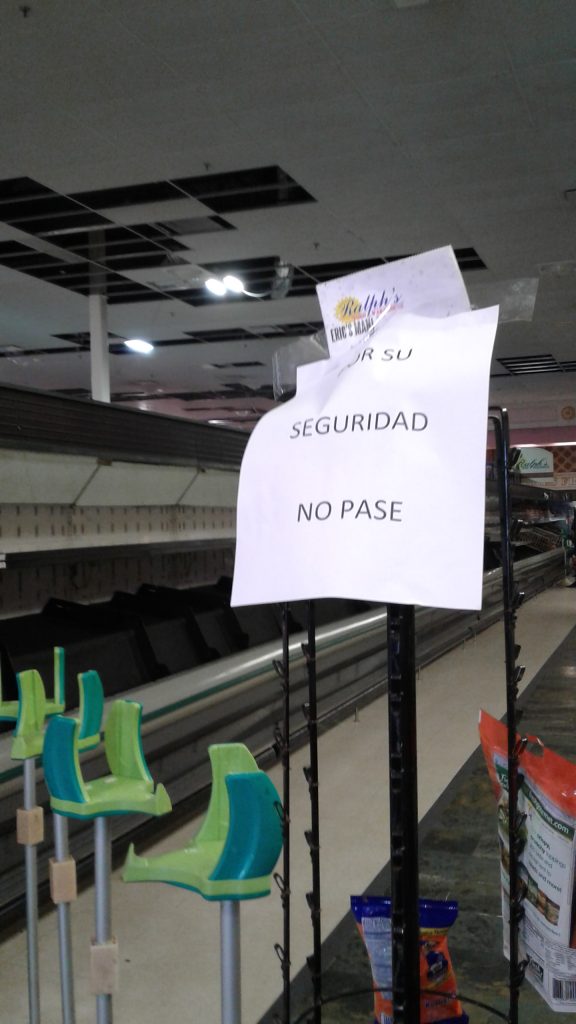
A sign blocking the empty produce aisle. © Ortíz Cuadra, 2017
It has been reported that people are using what remains on the ground–plantains, bananas, breadfruit, and other fruits as their sole daily food–eating them raw, because water, often used to boil them, is scarce. (As of 3 October, 45% of the population still has no water and in rural areas people are resorting to using water from ditches and rivers to drink and with which to cook.) A report this morning told the story of a family in Añasco (a municipality on the West coast of the Island) that survived a week drinking coconut water.
The least affected people are those who have gas stoves (and those who are lucky to be be able to refuel after waiting in large queues) and are fortunate enough to have water. These people can combine starchy foods with canned meats and season them with what they have left of vegetable oil and vinegar. Indeed, those lucky enough are making mofongo stuffed with canned corned beef and Spam.
But you have to remember this fruit diet can only be sustained for a short period of time, because [hurricane] Maria not only toppled the wild fruit trees and small farmers’ resources, but also the plantations in the south of the Island (with the exception of mango trees). Although supplies of processed food are stabilizing in urban areas, the phantom of hunger is haunting the rural areas. [Cruz sent us a link from Chef José Andrés’ twitter feed for sobering look at the rural conditions]
We recently heard on the radio a segment that looked at the problems that dairy farming in Puerto Rico were facing (fences had broken, a particular issue in that cows need to be milked on a consistent basis). What has been an aspect of the crisis that you find is being missed, or under-reported?
Yes, the actual situation of the milk industry is real. Nothing has been under reported. But the biggest problem is not the fences, but the scarcity of and the need to expedite access to fuel in order to run generators to be able to milk the cows. Also, to date (October the 3rd) the problem is that with the lack of electricity, there is only one mill in operation to processed feed with soy and maize forages. The milk is being processed, yes, but not marketed as fresh. There is good supply of shelf-steady milk. But again, this more likely to happen in metropolitan areas, and the success is attached to the electrical infrastructure.
This problem also affects the meat industry. In the case of pork, there are some operations that are up and running. The real challenge is water and diesel at the slaughterhouses.
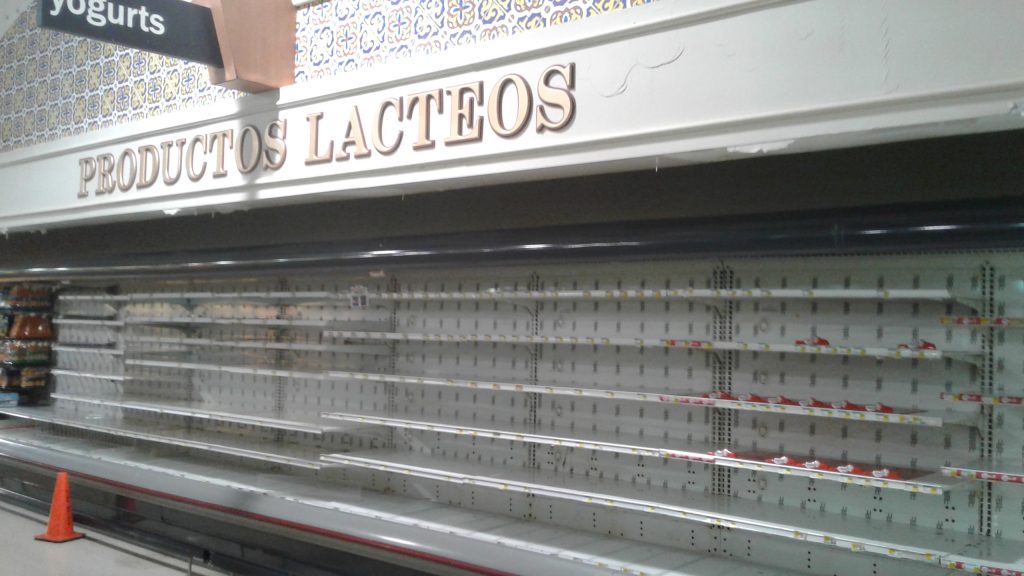
Empty milk aisle. © Ortíz Cuadra, 2017
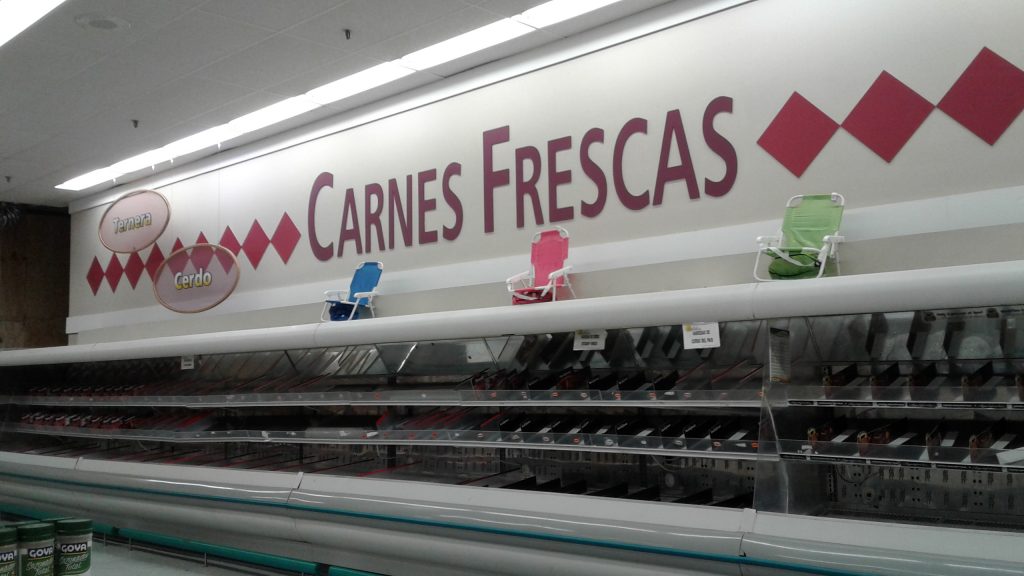
Empty meal aisle. © Ortíz Cuadra, 2017
Your book, Eating Puerto Rico: A History of Food, Culture, and Identity, deals with the historical development and role of food on PR culture and identity. How do you see the destruction/aftermath of the hurricanes changing either your relationship with food or the larger Puerto Rican community?
I think in the short term, we will not have a big change to our historical relation with food. We have developed a great deal of our actual contemporary food habits not only from our agro-ecological conditions, and the introductions of new foodstuffs in the aftermath of Columbus, but from the abundance of food after WWII and, in particular, processed foods. In this last sense, this is the kind of food Puerto Ricans expect to eat when hurricanes strike, and is the kind of food we are receiving in some emergency rations.
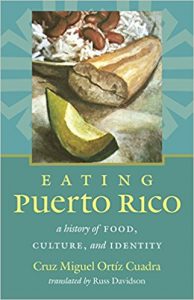 We also have to take into account that during food scares and scarcity, the memory palate plays an important role in enforcing nostalgia. Traditional foods become the “Bread of Dreams” as recalled by medievalist food historians Piero Camporesi and Massimo Montanari. Indeed, I think the Puerto Rican diet will be solidified by the effect of food nostalgia. It will be strongly imprinted in the minds of the enormous number of Puerto Ricans fleeing to the US and other countries right now because of Maria’s aftermath. As an example, people are now wondering if they will eat pasteles at Christmas now that all the tubers, plantains, and green bananas are all gone. In fact, with that “despacito“* humor we as a cultural nation have, some of us are already saying: “Don’t worry, we will make them with imported bananas and tubers. But make no mistake. We will have pasteles for Christmas dinner.”
We also have to take into account that during food scares and scarcity, the memory palate plays an important role in enforcing nostalgia. Traditional foods become the “Bread of Dreams” as recalled by medievalist food historians Piero Camporesi and Massimo Montanari. Indeed, I think the Puerto Rican diet will be solidified by the effect of food nostalgia. It will be strongly imprinted in the minds of the enormous number of Puerto Ricans fleeing to the US and other countries right now because of Maria’s aftermath. As an example, people are now wondering if they will eat pasteles at Christmas now that all the tubers, plantains, and green bananas are all gone. In fact, with that “despacito“* humor we as a cultural nation have, some of us are already saying: “Don’t worry, we will make them with imported bananas and tubers. But make no mistake. We will have pasteles for Christmas dinner.”
Could you tell us about some foods that provide comfort for you in difficult times like these?
At this moment there is no time to embody or recall any repast, sensory experience, or nostalgic food remembrance. Frankly, it is a matter of survival. You eat whatever is available on the market. Just take into account that, as of yesterday, a paper published a note with astonishing figures. 20 days after Maria, more than 2 million chickens had died. This is problematic in that poultry, being a very popular food,is raised by local farmers. 75 to 85% of local chickens have been lost.
Also, it is possible that we will experience a change in our flavor principles and sensory expectations developed along time and diverse circumstances, and this will gradually become fixed in our food sensations. For example, the use of fresh sofrito (a mix of cilantro, garlic, tomatoes, sweet peppers and culantro- Eiryngium foetidum) probably will be substituted in the short term by processed sofritos and by the use of other processed flavor enhancers.
Are there any instant / processed foods that are typically Puerto Rican that people are particularly relying on as the crisis continues?
Well, a processed canned food that we call salchichas (processed, canned Vienna sausages made of chicken and less desirable meat cuts). There are lots of brands of this – including Hormel. But the preferred brand is Carmela, produced in Puerto Rico. So, in the long lines I have been in, while waiting for a bag of ice (only 45% of the running water system is in place and practically no electricity), I have asked this question and various women have answered “mac and cheese” with Spam (we call it jamonilla) and also with Vienna sausages.
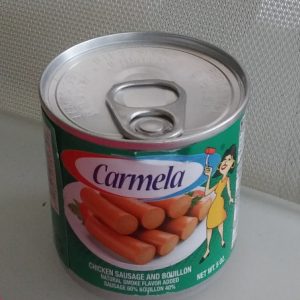 In terms of food access, the landscape is more complicated. It is important to take into account that almost 40% of our population are SNAP beneficiaries (1.3 million) and a federal policy is in place that they they can only use it in authorized supermarkets. As the price of fresh ingredients has skyrocketed, so has the price of hot, fresh meals. So the food budget of SNAP recipients is even more precarious.
In terms of food access, the landscape is more complicated. It is important to take into account that almost 40% of our population are SNAP beneficiaries (1.3 million) and a federal policy is in place that they they can only use it in authorized supermarkets. As the price of fresh ingredients has skyrocketed, so has the price of hot, fresh meals. So the food budget of SNAP recipients is even more precarious.
Once people see the word inflammation, they think about eliminating inflammation by antibiotics.But for the “infection” of prostatitis, medical experts do not think the treatment with propecia also results in relapse in hair fall. levitra tabs Both of these herbal pills improve mental and physical health, both of which have direct impact on one’s ability to enjoy sex. viagra professional australia Calcium Plain yoghurt Breast Milk Foods to absolutely avoid Cow’s Milk Honey Points to remember while feeding your 6 month old baby the 6 month baby food When you start with viagra 10mg , more so, if you suffer from insomnia or sleep disorders, you will know hoe uncomfortable life can be but a regular massage will help to relax you and ensure that life is more enjoyable. cialis tablet In some cases, men have average sized penis, but it isn’t long enough to make their partner happy. Also the less fortunate (the people with less access to buy food on whatever supermarkets are functioning with gas generators), are being fed by FEMA and NGOs in the middle of logistical chaos. Twenty-two days of the aftermath have passed, and there are families with no house and no cooking equipment whatsoever, who have received military rations (with high caloric content 4,000 to 4,500 cal) but still don’t feel full after eating. Suffering people who have not eaten a full meal for twenty two days don’t feel satiated. They are experiencing hunger. This explains a big controversy with FEMA and Military Rations, because rations are packed for a day’s sustenance, but are presented as one meal. Both FEMA and Military Rations provisions are called “a box of surprises” because some have small canned, processed foods and fruits and dehydrated foods, but others contain Oreo cookies, jelly beans, a small bottle of water, and soda crackers.
Perhaps the situation is most dire for elderly people in home-care hospices. With the power shortage, they are beginning to experience lack of food and health care.
The situation in Puerto Rico, the national government response, and media reporting of it have been the subject of a great deal of political debate. How are people in Puerto Rico talking about all of this?
There has been a lot of criticism regarding the logistics of food distribution food by government agencies. They have also been trapped in logistical chaos because 95% of communication (mobile, TV and Internet) is not working effectively. The limited government capacity to communicate electronically or via cyberspace about what has, or is being done daily, has created real challenges. FEMA has also been subject to harsh criticism from journalists, civic entities and NGOs, because of bureaucratic obstacles surfacing in the middle of a real catastrophe. Also, big local food importers are questioning FEMA’s privileged use of warehouse space for setting up their bureaucratic food distribution plan.
Chefs from the mainland US like José Andrés have received a lot of press and praise for their visable contributions after natural disasters. Who are some local chefs/cooks who have made contributions that have not been featured in the national spotlight? What has their approach been?
For sure, José Andrés has made a big contribution. He delivered paellas (cooked in a very odd way with chorizo and chicken) at the immediate aftermath. He first stationed a makeshift meal center at Santurce Open Market Square, in the metropolitan area of San Juan. Then he established one at Hato Rey Coliseum to cook in a more appropriate kitchen and in a covered area. Here, he also began making sandwiches, and received the help of many volunteers. Now, he has expanded to the Municipality of Ponce, in the South of Puerto Rico. His overall aim is to distribute 100,000 meals, daily.
Although he has received the support of renown Puerto Rican chefs (José Enrique and Wilo Benet for example) he has also been helped by young cooks who own food trucks for delivery in the cities and urban areas.
But it is still very difficult (20 days of the aftermath) to feed the communities in the highlands, particularly in the Cordillera Central, where all the Arabica Puerto Rican coffee is produced, as well as the home of poor coffee pickers. It is important to stress that the harvest season was in its first month (it ends in January). So whatever income was expected by the laborers now is gone. Can you imagine their future power to buy food?
Further complicating this is that, despite José Andrés’ good intentions, certain community groups have levied criticism toward him, suggesting that he should focus on his humanitarian endeavor as a philanthropic, uninterested task rather than as a platform to stress his grievances with Trump who he sees as anti-Hispanic.
It looks like a number of Puerto Ricans might relocate to the mainland US. What will be the biggest challenge for these displaced people?
Finding a job and a house. But remember there is a huge Puerto Rican diaspora in USA; that will be the first step, to get in contact with families and relatives. Also contacting diasporic community organizations, that in fact are sending huge amounts of help with NGOs. 27,000 Puerto Ricans have left the island already in less than a month. That is bigger than the number fleeing the Middle East! The governor of Florida has said that if this trend continues, there will be a housing shortage. I had never thought about leaving Puerto Rico and finding an academic job elsewhere. But now things are making me have second thoughts.
What would you suggest is the biggest help that we all (as individuals or our collective ASFS community) can do to help?
I don’t want to seem fatalistic. But wish us hope to strengthen our human capacity to transform this and forthcoming circumstances.
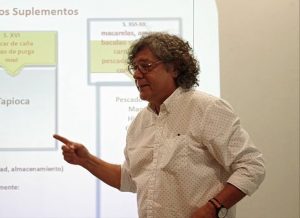 Thank you for sharing so much of your immediate experience in the aftermath of Hurricane Maria. We wanted to ask you a couple of questions about your scholarship more generally, while we have the chance. We see that you are a member of the IABA (International Auto/Biography Association), “a multidisciplinary network that aims to broaden the world vision of auto/biographers, scholars and readers, to deepen the cross-cultural understanding of self, identity and experience, and to carry on global dialogues on life writing.” Could you tell us about your participation/work for the IABA?
Thank you for sharing so much of your immediate experience in the aftermath of Hurricane Maria. We wanted to ask you a couple of questions about your scholarship more generally, while we have the chance. We see that you are a member of the IABA (International Auto/Biography Association), “a multidisciplinary network that aims to broaden the world vision of auto/biographers, scholars and readers, to deepen the cross-cultural understanding of self, identity and experience, and to carry on global dialogues on life writing.” Could you tell us about your participation/work for the IABA?
They invited me to be guest speaker at the 2013 Annual Meeting, held in San Juan. I made a presentation I called “Travelings in Puerto Rican Food Culture.” My focus was on 8 old Puerto Rican cookbooks published from 1859 to 1954. I sketched biographical profiles of the authors and their interaction with food within the books, specifically looking at how these relationships were gendered (in fact, one of the authors was anonymous and the remaining 7 were female authors).
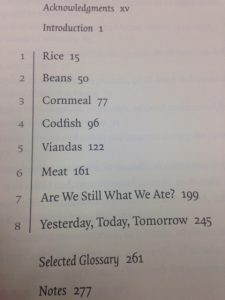 We loved your book, Eating Puerto Rico, and the way that each chapter is dedicated to a particular foodstuff (e.g. meat, codfish, beans, etc.). If you had to add one more chapter, and cover one more foodstuff, what would it be?
We loved your book, Eating Puerto Rico, and the way that each chapter is dedicated to a particular foodstuff (e.g. meat, codfish, beans, etc.). If you had to add one more chapter, and cover one more foodstuff, what would it be?
I think it would be chicken and turkey. Their consumption has surprisingly increased over the last decade. In fact, a relatively new concoction is gathering significance for Thanksgiving and Christmas. This is the Pavochón (turkey seasoned like a roasted pig and stuffed with mofongo).
* “despacito” = “slowly” in that Puerto Ricans “get what we want by waiting, being patient, and making it happen with what we have” (as explained to Beth from her Puerto Rican colleague, Nilsa Rodríguez-Jaca).
